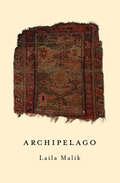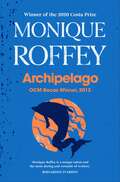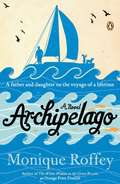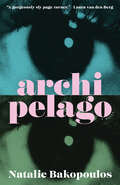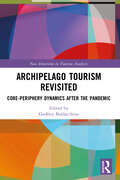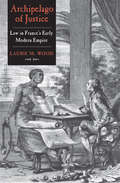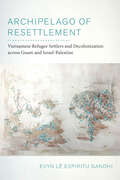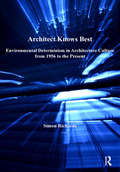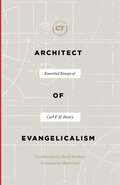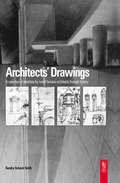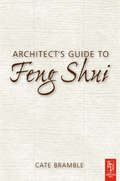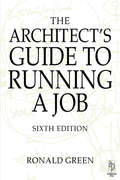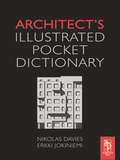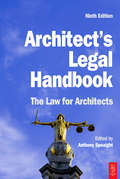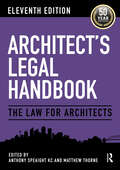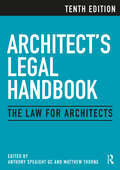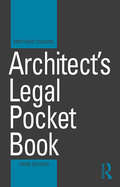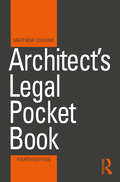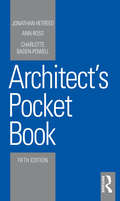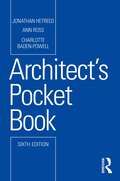- Table View
- List View
Archipelago
by Laila MalikThe islands of an archipelago are isolated above sea level but attached underwater; connected yet separate. archipelago, the debut poetry collection from Laila Malik, traces fragments of family, becoming and unbecoming against the shifting shorelines of loss, multigenerational migration, and (un)belonging.Malik's lyrical poems intertwine histories of exile and ecological devastation. Beginning with a coming of age in the 80s and 90s between Canada, the Arabian Gulf, East Africa and Kashmir, they subvert conventions of lineage, instead drawing on the truths of inter-ethnic histories amidst sparse landscapes of deserts, oceans, and mountains. They question why the only certainties of "home" are urgency and impossibility.At its core, archipelago is a letter to the daughters who come before and after, a quiet disclosure of barbed ancestral legacies that only come into focus through poetry.
Archipelago
by Monique RoffeyGavin Weald lives with his six-year-old daughter Ocean and their dog Suzy in a newly rebuilt pink house. It is only a few months since a devastating flood swept through their home, with heartbreaking consequences. Gavin is trying desperately to carry on, but wakes each night to his daughter's cries and his own fears for the future. One day he does the only thing he can think of: he takes his daughter and his dog down to the marina, to his old boat Romany which hasn't set sail in years, and embarks upon a voyage to make his peace with the waters. They set sail into deep open ocean, watch fish and dolphins leap from the waves, and head for the Caribbean archipelago that Gavin longed to explore as a younger man, before he fell in love with a woman and moored his boat for what he thought was the last time. Now Gavin has a new reason for wanderlust and an unexpected crew, who are about to discover the full power and majesty of the sea. A miraculous journey awaits, new sights and wonders - but it will take more than an ocean to put the memory of the flood behind them. . .
Archipelago
by Monique RoffeyThe magical new novel from the Orange Prize shortlisted author of The White Woman on the Green Bicycle will take you on a journey like no other. . . Gavin Weald lives with his six-year old daughter Océan and their dog Suzy in a newly rebuilt pink house. It is only a few months since a devastating flood swept through their home, with heartbreaking consequences. Gavin is trying desperately to carry on, but wakes each night to his daughter's cries and his own fears for the future. So one day he does the only thing he can think of: he takes his daughter and his dog down to the marina, to his old boat Romany which hasn't set sail in years, and embarks upon a voyage to make his peace with the waters. They set sail into deep open ocean, watch fish and dolphins leap from the waves, and head for the Caribbean archipelago that Gavin longed to explore as a younger man, before he fell in love with a woman and moored his boat for what he thought was the last time. Now Gavin has a new reason for wanderlust and an unexpected crew, who are about to discover the full power and majesty of the sea. A miraculous journey awaits, new sights and wonders - but it will take more than an ocean to put the memory of the flood behind them. . . Praise for Archipelago: 'There's a warmth to this book, an exuberance and a wisdom, that makes the experience of reading it feel not just pleasurable but somehow instructive. It's funny, sometimes bitingly poignant. A brilliant piece of storytelling' Andrew Miller, author of Pure, winner of the Costa Book of the Year 2011
Archipelago
by Natalie BakopoulosNatalie Bakopoulos’s Archipelago is a striking, haunting novel that offers meditations on the slippery borders of nations, languages, middle age, and the self. Along the way to a translation writing residency on the Dalmatian coast, Archipelago’s unnamed narrator has an unsettling, aggressive encounter with a man on a ferry, which sets off a series of strange events. At the residency, she reunites with Luka, an old friend who seems to have included a version of her in his novel. They strike up a romantic relationship as she continues her translation work. The hazy summer stretches on until, after a sudden shift, she embarks upon an impulsive road trip back to Greece, crossing borders. Spare and lyrical, with subversions of the Odyssey and its singular Ithaca, Archipelago charts a wending journey back to the narrator’s family house—not simply back to a self and home, but beyond it.
Archipelago Tourism Revisited: Core-Periphery Dynamics after the Pandemic (New Directions in Tourism Analysis)
by Godfrey BaldacchinoThis timely and innovative book explores the dynamics of inter-island/island-island tourism – also known as archipelago tourism – on the cusp of the post-pandemic epoch.Embellished with illustrative maps and diagrams, the volume examines what novel approaches have been developed, if at all, so as not to repeat past mistakes, and nurture a more sustainable, 'island tourism' business model. It looks at how the political-economic relationship between main and outer islands changed during the pandemic and, if so, whether this shift has had a bearing on current tourism policy. The book also explores how these and other changes are reflected in how: islands are branded; island destinations are marketed; and island transport logistics play out. An array of archipelagos of varying sizes and locations is explored, assuring a global perspective. The book furthers our understanding of core-periphery dynamics in archipelago tourism.The volume will be of interest to students, researchers, policy makers and academics in the fields of tourism policy and planning, sustainability, island studies and development studies.
Archipelago Tourism: Policies and Practices (New Directions in Tourism Analysis)
by Godfrey BaldacchinoExploring the conceptual insights provided by the archipelagic 'twist' in the context of tourism principles, policies and practices, this volume draws on an international series of case studies to analyse best practice in branding, marketing and logistics in archipelago tourist destinations. The book asks and seeks to answer such questions as: How to 'sell' a multi-island destination, without risking a message that may be too complex and diffuse for audiences to grab on to? Does one encourage visitors to do 'island hopping'; and, if so, how and with what logistic facilities? How does one ascribe specific island destinations within an overall archipelago brand? Would smaller islands rebel against a composite branding strategy that actually benefits other islands? How does one read or craft transport policies as a function of the 'reterritorialisation' of a multi-island space? This book pioneers the exploration of the archipelago as tourism study focus (and not just locus); a heuristic device for rendering islands as sites of different tourism practices, industries and policies, but also of challenges and possibilities.
Archipelago of Justice: Law in France's Early Modern Empire
by Laurie M. WoodAn examination of France’s Atlantic and Indian Ocean empires through the stories of the little-known people who built it This book is a groundbreaking evaluation of the interwoven trajectories of the people, such as itinerant ship-workers and colonial magistrates, who built France’s first empire between 1680 and 1780 in the Atlantic and Indian Oceans. These imperial subjects sought political and legal influence via law courts, with strategies that reflected local and regional priorities, particularly regarding slavery, war, and trade. Through court records and legal documents, Wood reveals how courts became liaisons between France and new colonial possessions.
Archipelago of Resettlement: Vietnamese Refugee Settlers and Decolonization across Guam and Israel-Palestine (American Crossroads #65)
by Evyn Lê Espiritu GandhiA free open access ebook is available upon publication. Learn more at www.luminosoa.org. What happens when refugees encounter Indigenous sovereignty struggles in the countries of their resettlement? From April to November 1975, the US military processed over 112,000 Vietnamese refugees on the unincorporated territory of Guam; from 1977 to 1979, the State of Israel granted asylum and citizenship to 366 non-Jewish Vietnamese refugees. Evyn Lê Espiritu Gandhi analyzes these two cases to theorize what she calls the refugee settler condition: the fraught positionality of refugee subjects whose resettlement in a settler colonial state is predicated on the unjust dispossession of an Indigenous population. This groundbreaking book explores two forms of critical geography: first, archipelagos of empire, examining how the Vietnam War is linked to the US military buildup in Guam and unwavering support of Israel, and second, corresponding archipelagos of trans-Indigenous resistance, tracing how Chamorro decolonization efforts and Palestinian liberation struggles are connected through the Vietnamese refugee figure. Considering distinct yet overlapping modalities of refugee and Indigenous displacement, Gandhi offers tools for imagining emergent forms of decolonial solidarity between refugee settlers and Indigenous peoples.
Archisketcher: Drawing Buildings, Cities and Landscapes
by Simone Ridyard"For urban sketchers...each new city is a clean white page."There is nothing quite like the thrill of heading out on the town, sketchbook in hand, in search of a view worth capturing. Archisketcher will help you embrace the excitement of sketching on location while overcoming common challenges. You'll see that you don't need to be an architect to draw architecture confidently. Nor do you need to understand the intricate details of perspective, design or color theory. This dynamic handbook tells you just what you need to know to create sketches that work well compositionally, provide a sense of depth and scale, and--most importantly--capture the true spirit of place.Richly illustrated with urban landscapes from around the world--from skyscrapers in Asia, to picturesque English villages, to Mediterranean hill townsTwo-page spreads present various artists' interpretations of Notre Dame, the Brooklyn Bridge and other iconic landmarksFeatures ten spotlights on contemporary urban sketchers who discuss the architectural styles and features in their own neighborhoods, from Montreal to Madrid From architectural portraits to bustling streetscapes to sweeping skylines, the art of urban sketching comes alive on these pages. Whether you aspire to capture the pulse of cities afar or your own hometown, the art and ideas in this book will make your efforts more successful and enjoyable.
Archispeak: An Illustrated Guide to Architectural Terms
by Tom PorterWidely used in architectural circles in the heat of discussion, the recurrent use of particular words and terms has evolved into a language of design jargon. Commonly found in architectural literature and journalism, in critical design debate and especially in student project reviews, Archispeak can seem insular and perplexing to others and -- particularly to the new architectural student -- often incomprehensible.There is a need to translate architectural design concepts into spoken and written commentary -- each word in use embodying a precise and universally accepted architectural meaning. If we explore the vocabulary of this language we gain insight into good design practice and into collective understanding of what constitutes a refined architecture. This unique illustrated guide will help students understand the nuances of this specialized language and help them in communicating their own design ideas.
Architect Knows Best: Environmental Determinism in Architecture Culture from 1956 to the Present (Ashgate Studies In Architecture Ser.)
by Simon RichardsThe idea that buildings could be used to reform human behaviour and improve society was fundamental to the 'modernist' architecture and planning of people like Walter Gropius, Le Corbusier and José Luis Sert in the first half of the 20th century. Their proposals for functional zoning, multi-level transport, high-rise living, and machine-inspired aesthetics came under attack from the 1950s onwards, and many alternative approaches to architecture and planning emerged. It was thought that the environmental determinist strand of the discourse was killed off at this time as well. This book argues that it was not, but on the contrary, that it has deepened and diversified. Many of the most prominent architect-planners continue to design with a view to improving the behaviour of individual people and of society at large. By looking at - and interviewing - major figures and movements of recent years in Britain, Europe and America, including Léon Krier, Peter Eisenman, Andrés Duany, Jane Jacobs, Robert Venturi and Denise Scott Brown, it demonstrates the myriad ways that architect-planners seek to shape human behaviour through buildings. In doing so, the book raises awareness of this strand within the discourse and examines its different purposes and manifestations. It questions whether it is an ineradicable and beneficial part of architecture and planning, or a regrettable throwback to a more authoritarian phase, discusses why is it seldom acknowledged directly and whether it could be handled more responsibly and with greater understanding. Richards does not provide any simple solutions but in conclusion, is critical of architect-planners who abuse the rhetoric of social reform simply to leverage their attempts to secure building commissions, while being more sympathetic towards those who appear to have a sincere desire to improve society through their buildings.
Architect of Air Power: General Laurence S. Kuter and the Birth of the US Air Force (American Warriors Series)
by Brian D. LaslieA biography of the pioneering four-star general, chronicling his influence on the United States Air Force.At age 36, Laurence S. Kuter (1905–1979) became the youngest general officer since William T. Sherman. He served as deputy commander of allied tactical air forces in North Africa during World War II and helped devise the American bombing strategy in Europe. Although his combat contributions were less notable than other commanders in the Eighth Air Force, few officers saw as many theaters of operation as he did or were as highly sought-after. After World War II, he led the Military Air Transport Service, Air University, Far East Air Forces, and served as commander-in-chief of the North American Air Defense Command (NORAD). Despite these accomplishments and others, however, Kuter remains widely underappreciated.In Architect of Air Power, Brian D. Laslie offers the first biography of this important but unsung pioneer whose influence can be found in every stage of the development of an independent US Air Force. From his early years at West Point to his days at the Air Corps Tactical School to his leadership role at NORAD, Kuter made his mark with quiet efficiency. He was an early advocate of strategic bombardment rather than pursuit or fighter aviation?fundamentally changing the way air power was used?and later helped implement the Berlin airlift in 1948. In what would become a significant moment in military history, he wrote Field Manual 100-20, which is considered the Air Force’s “declaration of independence” from the Army.Drawing on diaries, letters, and scrapbooks, Laslie offers a complete portrait of this influential soldier. Architect of Air Power illuminates Kuter’s pivotal contributions and offers new insights into critical military policy and decision-making during the Second World War and the Cold War.Praise for Architect of Air Power“Laslie expertly brings into focus perhaps the least known of the major Air Force personalities of World War II and the early Cold War. Kuter was the indispensable “behind-the-scenes” man in those years, and this book fills a similarly indispensable gap in our understanding of the people and ideas that propelled the nation’s air arm to independence and prominence.” —Thomas Alexander Hughes, author of Over Lord: General Pete Quesada and the Triumph of Tactical Air Power in World War II“Laslie’s outstanding work on Laurence Kuter is the first full and highly effective look at this exceptionally important airman. It gives the reader ample evidence of Kuter’s central role in making America the quintessential airpower nation during the course of the twentieth century. This will be the book on Kuter for many years to come.” —Robert S. Ehlers, Jr., author of The Mediterranean Air War: Airpower and Allied Victory in World War II
Architect of Evangelicalism: Essential Essays of Carl F. H. Henry (Best of Christianity Today)
by Carl F. H. HenryDiscover the ongoing relevance of the essential evangelical. In recent years, the label "evangelical" has been distorted and its usefulness questioned. No one is better equipped to provide a clear understanding of evangelicalism than the late Carl F. H. Henry, the founding editor of Christianity Today and the most influential theologian of American evangelicalism in the twentieth century. While Billy Graham was preaching the gospel to stadiums full of people, Henry was working tirelessly to help Christians adopt a worldview that encompasses all of life. Architect of Evangelicalism helps us gain a better sense of the roots of American evangelicalism by giving us the best of Henry's Christianity Today essays on subjects such as what defines evangelicalism, what separates it from theological liberalism, what evangelical Christian education should look like, and how evangelicals should engage with society.
Architect's Drawings
by Kendra Schank SmithThe sketch is a window into the architects mind. As creative designers, architects are interested in how other architects, particularly successful ones, think through the use of drawings to approach their work. Historically designers have sought inspiration for their own work through an insight into the minds and workings of people they often regard as geniuses. This collection of sketches aims to provide this insight. Here for the first time, a wide range of world famous architects' sketches from the Renaissance to the present day can be seen in a single volume. The sketches have been selected to represent the concepts or philosophies of the key movements in architecture in order to develop an overall picture of the role of the sketch in the development of architecture. The book illustrates the work of designers as diverse as Andrea Palladio, Erich Mendelsohn, Sir Edwin Lutyens, Gianlorenzo Bernini, Le Corbusier, Michelangelo, Alvar Aalto, Sir John Soane, Francesco Borromini, Walter Gropius, and contemporary architects Tadao Ando, Zaha Hadid and Frank Gehry to name but a few. Each chronologically placed sketch is accompanied by text providing details about the architect’s life, a look at the sketch in context, and the connection to specific buildings where appropriate. Style, media and meaning are also discussed, developing an explanation of the architect’s thinking and intentions. As creative designers themselves, architects are interested in how other architects, particularly successful ones, think and draw and approach their work. Historically designers have sought inspiration for their own work through an insight into the minds and workings of people they often regard as geniuses. This collection of sketches aims to provide this insight.Listed chronologically each sketch will be accompanied by a text which provides: A short synopsis/history of the architect's life; a look at the sketch in this context; the connection to a specific building (where appropriate); techniques of the sketch: style and media; meaning - what the sketch shows about the architect's thinking and intentions followed by a select bibliography for each section.
Architect's Guide to Feng Shui
by Cate BrambleCate Bramble has devoted her career to highlighting the differences between 'feng shui-lite' as a fashionable pursuit in contrast to the original intentions of the Chinese masters. Here she presents the authentic principles in a technical, no-nonsense pocket book specifically for architects. As clients become more demanding and the competition for projects heats up, the architect is well advised to have many strings to their bow. This practical guide includes line illustrations that present the principles of feng shui, the Chinese art or practice in which a structure or site is chosen or configured so as to harmonize with the spiritual forces that inhabit it, and their application in architecture through planning principles, services, building elements and materials, in an accessible, easy reference format. The feng shui-savvy architect can also benefit from feng shui's ability to match structures and land, and the peculiar capacity of authentic feng shui to forecast development-related concerns including cost overruns, quality issues - even worker injuries and trade disputes!The author explains feng shui from archaeological sources and evidence of practice in the east, contrasting it with what passes for feng shui in the west. She analyses the practice in terms of such concepts as western systems theory, viewshed, space syntax and the 'pattern landscape' theory of urban planning. For the first time, the Sustainable implications of feng shui design are explained with reference to the latest developments in behavioural and cognitve sciences, evolutionary biology and other western viewpoints.
Architect's Guide to Running a Job
by Ronald GreenBest practice is the concern of this book. An architect has to be an administrator as well as designer, and smooth economical administration will provide the conditions under which client relations can be constructive and good design can be acheived.The book is divided into 76 short sections covering the entire process, from preliminary enquiries to final fees, each with a small flow chart showing who is involved and when. This sixth revised edition updates the contents in line with present day practice, bearing in mind the changes in terminology, technology, environmental demands and the legislative background.Ronald Green and Professor Ross Jamieson who writes the foreword to this edition, are both examiners for Part Three.
Architect's Illustrated Pocket Dictionary
by Nikolas Davies Erkki JokiniemiThis pocket-sized Dictionary offers huge coverage for the 40,000+ people studying or working in architecture, construction or any of the built environment fields. From Abaciscus to Zophorus, the reader is able to quickly track down precisely the term they are looking for. The book is illustrated with stunning drawings that provide a visual as well as a textual definition of both key concepts and subtle differences in meaning. Compact and affordable; Davies and Jokiniemi's work is the miniature version of the Dictionary of Architecture and Building Construction. The Architect’s Illustrated Pocket Dictionary can be used on site or quickly at the desk and is suitable for all those interested in the buildings that surround us.
Architect's Legal Handbook: The Law For Architects (Architectural Press Legal Guides)
by Anthony SpeaightArchitect's Legal Handbook is the most widely used reference on the law for architects in practice, and the established leading textbook on law for architectural students. The ninth edition includes all the latest development in the law that affect an architect’s work, and comprehensive coverage of relevant UK law topics. Most significantly, the chapter on the JCT contracts has been completely revised to cover the 2005 update. Contributions by the foremost legal and architectural experts in the UK Full coverage of the JCT 2005 update New chapter on procurement Selected bibliography provides useful references to further reading Tables of Cases, Statutes and Statutory Instruments provide full referencing for cited cases Architect’s Legal Handbook is the essential legal reference work for all architects and students of architecture.
Architect's Legal Handbook: The Law for Architects
by Anthony Speaight Matthew ThorneCelebrating 50 years since it was first published, the Architect’s Legal Handbook has been the most widely used reference on the law for practicing architects, and the established textbook on law for architectural students. Since the last edition of this book in 2021, unprecedented change has occurred in the construction sector. The withdrawal of the United Kingdom from the European Union has ushered in changes to legislation in a wide range of areas. The tragic fire at Grenfell Tower in June 2017 and the deficiencies in design, construction, and regulation within the sector that were revealed as a result have given rise to major changes in the way projects are now carried out. An overhaul of the Building Regulations and the creation of a new Building Safety Regulator are only some of the ways in which the landscape has changed. This eleventh edition features all the latest developments in the law which affect an architect’s work, as well as providing comprehensive coverage of relevant UK law topics. Key highlights of this edition include: A new chapter has been added to cover the statutory framework for building safety (Chapter 9), which is complemented by a wholly updated chapter on construction regulation in England and Wales (Chapter 10). The chapter on public procurement law (Chapter 14) has also been entirely rewritten to focus on the Public Procurement Act 2023 and related regulations, following Brexit. New suites of standard contract forms have, since the last edition, been issued. These have seen substantial changes with chapters on JCT 2024 (Chapter 18) and the latest NEC4 forms (Chapter 19), together with wider updates to the chapters on FIDIC (Chapter 20) and other forms of contract (Chapter 21). A revised chapter on architects’ contracts with clients covering the RIBA Professional Services Contract 2024 (Chapter 37). A new section on novations in the chapter on the English Law of Contract (Chapter 2). The Architect’s Legal Handbook is the essential legal reference work for all architects and students of architecture.
Architect's Legal Handbook: The Law for Architects
by Anthony Speaight QC and Matthew ThorneThe Architect's Legal Handbook is the most widely used reference on the law for practicing architects and the established textbook on law for architectural students. Since the last edition of this book in 2010, the legal landscape in which architecture is practised has changed significantly: the long-standing procurement model with an architect as contract administrator has been challenged by the growing popularity of design and build contracts, contract notices in place of certificates, and novation of architect’s duties. The tenth edition features all the latest developments in the law which affect an architect's work, as well as providing comprehensive coverage of relevant UK law topics. Key highlights of this edition include: an overview of the legal environment, including contract, tort, and land law; analysis of the statutory framework, including planning law, health and safety, construction legislation, and building regulations in the post-Grenfell legal landscape; procurement and the major industry construction contract forms; building dispute resolution, including litigation, arbitration, adjudication, and mediation; key fields for the architect in practice, including architects’ registration and professional conduct, contracts with clients and collateral warranties, liability in negligence, and insurance; entirely new chapters on various standard form contracts, architects’ responsibility for the work of others, disciplinary proceedings, and data protection; tables of cases, legislation, statutes, and statutory instruments give a full overview of references cited in the text. The Architect’s Legal Handbook is the essential legal reference work for all architects and students of architecture.
Architect's Legal Pocket Book (Routledge Pocket Books)
by Matthew CousinsA little book that's big on information, the Architect's Legal Pocket Book is the definitive reference on legal issues for architects and architectural students. This handy pocket guide covers key legal principles which will help you to quickly understand the law and where to go for further information. Now in a fully updated new edition, this bestselling book covers a wide range of subjects focused on the UK including building legislation, negligence, liability, planning policy and development, listed buildings, party wall legislation, and rights of light. This edition also contains greater coverage of contracts including the RIBA contracts, dispute resolution and legal issues in professional practice. Illustrated with clear diagrams and featuring key cases, this is an invaluable source of practical information and a comprehensive guide of the current law for architects. It is a book no architect should be without.
Architect's Legal Pocket Book (Routledge Pocket Books)
by Matthew CousinsA little book that’s big on information, the Architect’s Legal Pocket Book is the definitive reference guide on legal issues for architects and architectural students. This handy pocket guide covers key legal principles which will help you to quickly understand the law and where to go for further information. Now in its third edition, this bestselling book has been fully updated throughout to provide you with the most current information available. Subjects include contract administration, building legislation, planning, listed buildings, contract law, negligence, liability and dispute resolution. This edition also contains new cases and legislation, contracts including the RIBA contract administration certificates, inspection duties, practical completion, the Hackitt review, the Report of the Independent Inquiry into the Construction of Edinburgh Schools and practical issues facing architects. Illustrated with clear diagrams and featuring key cases, this is a comprehensive guide to current law for architects and an invaluable source of information. It is a book no architect should be without.
Architect's Legal Pocket Book (Routledge Pocket Books)
by Matthew CousinsA little book that is big on information, the Architect’s Legal Pocket Book is the definitive reference guide on legal issues for architects and architectural students. This handy pocket guide covers key legal principles which will help you to quickly understand the law and where to go for further information.Now in its fourth edition, this bestselling book has been fully updated throughout to provide you with the most current information available. Subjects include contract administration, building legislation, planning, listed buildings, contract law, negligence, liability and dispute resolution. This edition also contains new cases and legislation, building safety, contracts, inspection duties, practical completion and practical issues facing architects.Illustrated with clear diagrams and featuring key cases, this is a comprehensive guide to current law for architects and an invaluable source of information. It is a book no architect should be without.
Architect's Pocket Book (Routledge Pocket Books)
by Jonathan Hetreed Ann Ross Charlotte Baden-PowellThis handy pocket book brings together a wealth of useful information that architects need on a daily basis – on-site or in the studio. It provides clear guidance and invaluable detail on a wide range of issues, from planning policy through environmental design to complying with Building Regulations, from structural and services matters to materials characteristics and detailing. This fifth edition includes the updating of regulations, standards and sources across a wide range of topics. Compact and easy to use, the Architect’s Pocket Book has sold well over 90,000 copies to the nation’s architects, architecture students, designers and construction professionals who do not have an architectural background but need to understand the basics, fast. This is the famous little blue book that you can’t afford to be without.
Architect's Pocket Book (Routledge Pocket Books)
by Jonathan Hetreed Ann Ross Charlotte Baden-PowellThis handy pocket book brings together a wealth of useful information that architects need on a daily basis – on-site or in the studio. It provides clear guidance and invaluable detail on a wide range of issues, from planning policy through environmental design to complying with Building Regulations, from structural and services matters to materials characteristics and detailing. This sixth edition includes the updating of regulations, standards and sources across a wide range of topics, with a particular focus on sustainability issues. Compact and easy to use, the Architect’s Pocket Book has sold well over 100,000 copies to the nation’s architects, architecture students, designers and construction professionals who do not have an architectural background but need to understand the basics, fast. This is the famous little blue book that you can’t afford to be without.
